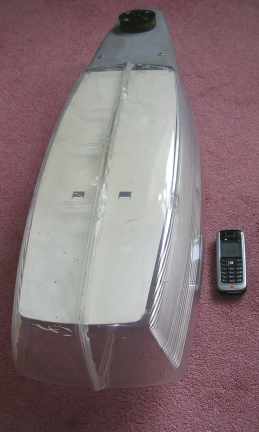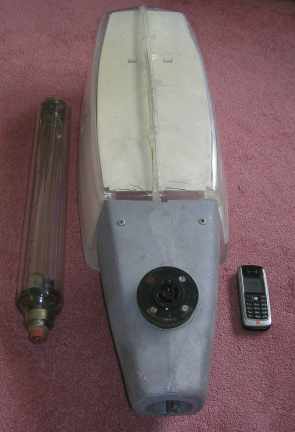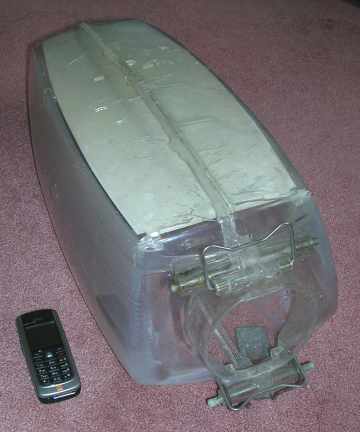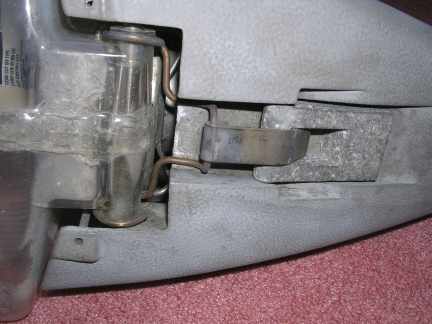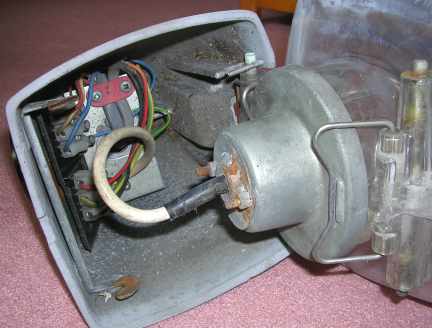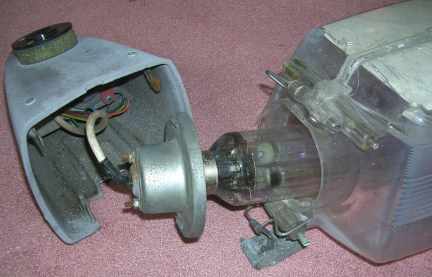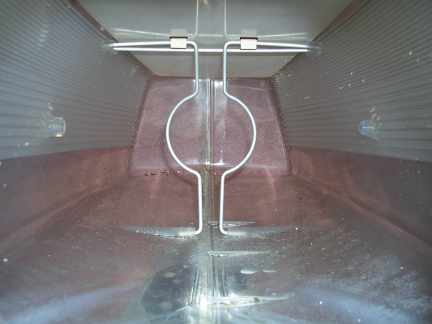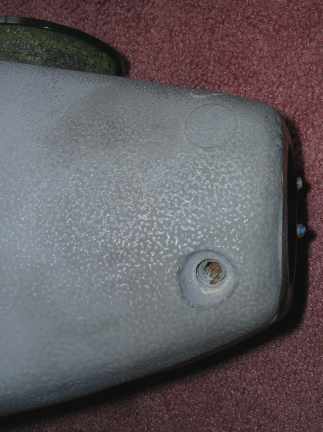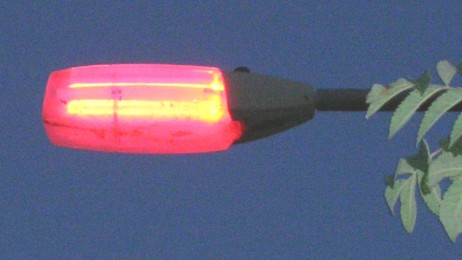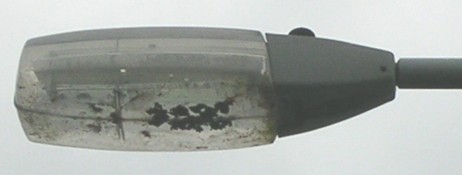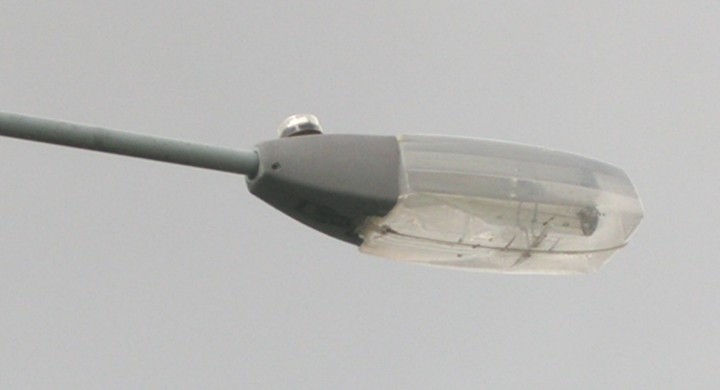|
Thorn Alpha-One 90-watt SOX remote-geared lantern. Starting life as an award winning Atlas design, the Alpha-One was radically different to its contemporaries in having a totally enclosed plastic-bowl assembly into which the sodium lamp is sealed. This enclosed bowl-unit was known as the 'Opticell' and this was mounted on to the lantern's aluminium housing. Because of the lantern's clever design, light distribution and output from the lantern was excellent, especially when the bowl was in good, clean condition. Looking at the lantern from ground level gives the impression that the bowl allows light to escape through the top of the lantern, but a closer inspection will reveal an aluminium reflector plate mounted in the top of the Opticell to reflect light downwards onto the road surface below.
The Thorn Alpha-One is only suitable for side-entry mounting; it was available as either a 55w or 90w sodium lantern. The picture shows an unusual column configuration, with a 90w lantern on the left arm and a 55w lantern on the right arm. This small installation was in Toton, Nottinghamshire, but all were removed in March 2005. Unfortunately, while the lantern’s Opticell design was quite a radical departure from the norm, it was also the Achilles-heel of the lantern. The problem lay in the construction of the Opticell, which is made from two separate sections of moulded clear plastic, bonded together to make the ‘cell’. Sadly, the seam between the two sections couldn’t always be made to be totally water-tight in the longer term, and any failure of the seal allowed water and particle ingress in to the lantern, eventually resulting in the failure of the lamp. Another problem is that once the inside of the Opticell becomes dirty, it cannot be easily accessed to clean it out, and replacement Opticells were expensive. It was a problem that the manufacturer never really cured and in turn has led to the premature replacement of many of these lantern from service. However, despite the non-availability of replacement bowls in 2006, some local authorities have persevered to prolong the life of their Alpha-Ones, even resorting to using clear silicone sealant around the opticell seam in an attempt to prevent water ingress. Despite the troubles with the Alpha-One, many of these venerable lanterns continue to give long service throughout the UK. Many streetlighting collectors seem to hold the Alpha-One lantern in high regard. If they haven't got an example in their collection, then they're usually high on their list of 'wants'. So let's take a closer look at this ledgendary lantern.
This later Thorn Alpha-One (MK15 model) originally came from Wolverhampton in the West Midlands. These front and rear views show the general appearance of the lantern from above, and also reveal the reflector plate mounted in the top of the Opticell; not always apparent from ground level. The lantern is pictured with a mobile phone next to it to give an idea of scale, and also a Philips 90w SOX Plus lamp, which is typical of the sort of sodium lamps used in Alpha-One's.
The Opticell, showing the lampholder mounting flange, retaining clips, and the pivot pins that locate the Opticell into the aluminium housing. The idea of sealing the lamp inside a totally enclosed plastic-cell, with integrally moulded refractor panels, would be a brilliant one - if it wasn't for the problems associated with making the seam around the Opticell watertight in the long-term. The factory-glued seal is plain to see, running right around the Opticell, but the white water marks on the inside back corners of the cell indicate where water has leaked in.
Here's a close up of the quick-release toggle faster which is found beneath the lantern's housing. The toggle fastener is actually part of the Opitcell's assembly, and not part of the housing where it locates into. When the Opitcell is fixed into position, the plastic moulding holding the bottom pivot pin (show n in this picture) is a weak area and can easily fracture due to the strain put on it by the toggle fastener.
With the toggle fastener released, we can open up the lantern for a closer look at what's inside. The method used to fix the lampholder into the Opticell with spring-clips is apparent. Also note the Opticell's hinge-pin (located in the housing), which allows the Opticell to hinge clear of the housing for maintenance. The electrics consist of terminal blocks for the live feed, earth, lampholder, and NEMA control switch.
In this picture, I've completely removed the housing from the Opticell to give a clearer view of the assembly. With the spring-clips released the lampholder has been withdrawn from the Opticell with the lamp still attached; this usually requires a little effort because the spring-loaded lampholder inside the Opticell tends to hold the lamp quite tightly. This view also illustrates the way in which the toggle fastener is attached to the Opticell.
An insect's view of inside the Opticell; the lamp support is made from hard-aluminium wire and has a spring-action to it, so it grips the lamp quite tightly. The 55w version would look similar, but the lamp support would be smaller in diameter. White coloured watermarks can be seen in the bottom of the cell where a pool of water has gathered in the past.
At the rear of the housing is located the two allen screws that lock the housing on to the bracket arm. These two (troublesome) screws tend to 'cold-rust' themselves into the casting, so without some force and heat on them they're nearly always impossible to budge; resulting in the lighting engineers having to hammer the fitting off the bracket!. As a comparison to the MK15 lantern, these housings (seen upside down) are from two earlier Alpha-One Mk1 lanterns; having a screw fixing lampholder instead of a toggle-clip fixing for the Opticell. The fixing screw can be seen in the housing on the left, and the lampholder on the right shows where it screwed into the fitting. The two will be made into one good example when the restoration finally takes place.
A rather surreal picture of an in-service Thorn Alpha-One during its evening 'start-up' in the winter of 2004-5.
This Thorn Alpha-One has allowed the ingress of water, insects, and debris into the Opticell.
The Opticell's seam has also failed on this MK15 example, as the pool of water inside the Opiticell reveals, but there is little or no particle ingress. This later Alpha-One is fitted with a single-part photocell and was located on Northwood Park Estate, Wolverhampton until its removal in August 2005. |
Copyright(c) 2005 Claire Pendrous. All rights reserved.
Please note that all pictures are by Claire Pendrous, or are part of the Claire Pendrous photographic collection unless otherwise stated; none of these images can be copied without obtaining prior permission.












